Sabudana Khichdi is a marvel of taste and texture. This dish of perfectly chewy tapioca pearls and crispy-creamy potatoes is punched up with crunchy roasted peanuts and the perfect balance of tangy, sweet, and spicy elements. Fasting or not, this is a fantastic dish to master, and with my tips, you’ll never have to worry about sticky khichdi again!
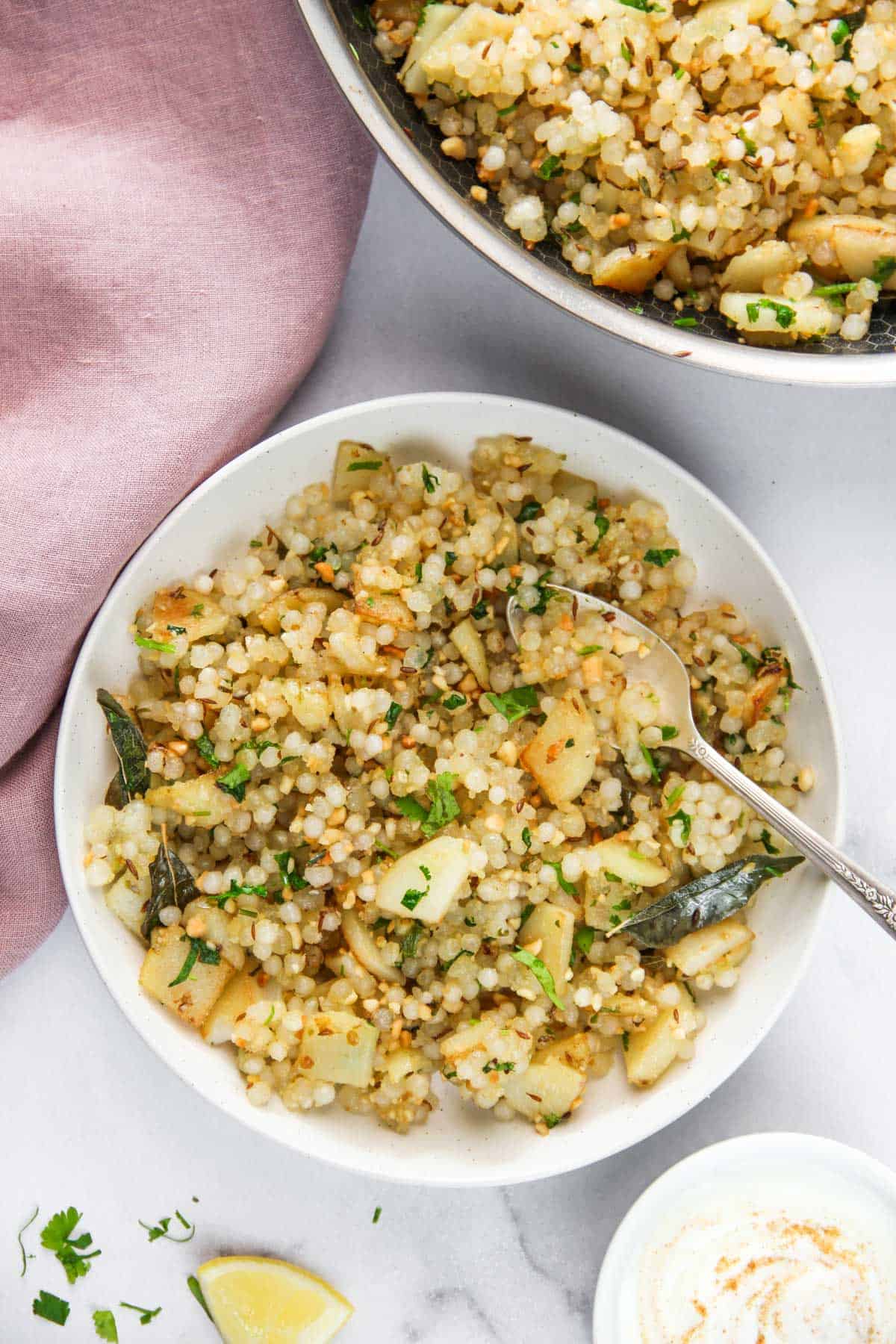
Want to Save This Recipe?
Enter your email & I'll send it to your inbox. Plus, get great new recipes from me every week!
By submitting this form, you consent to receive emails from Minstry of Curry
Jump to:
What is Sabudna Khichdi
In India, Sabudana Khichdi is easily one of the most popular fasting recipes, especially during Navratri. As a fasting meal, my mom usually skips the curry leaves and cilantro, which add signature flavor and extra nutrition when included in non-fasting meals. Sabudana Khichdi is also a super satisfying one-pot family meal that you can serve anytime. Many of my friends also add veggies like diced carrots and peas, so if you want to up the veggies in this dish, go for it!
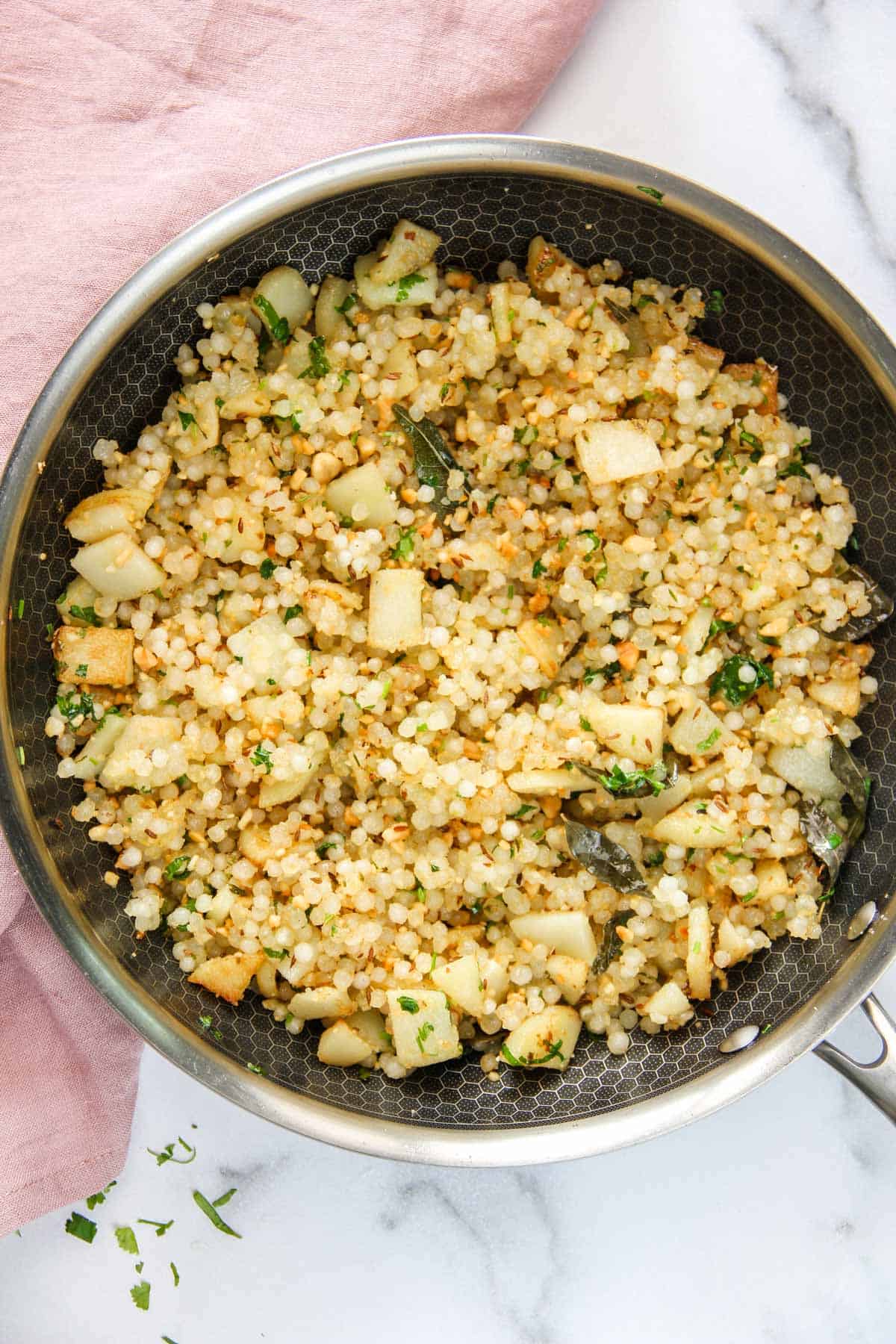
What is Sabudana
Sabudana also known as sago or tapioca pearls is often used in India to cook foods that are approved for fasting ("Upwas" in Marathi / "Vrat" in Hindi). Growing up we always had sabudana khichdi, Sabudana Vada, or Sabudana Thalipeeth for festivals like Navratri, Mahashivratri, and Ashadhi Ekadashi. When cooked properly (*see my tried and true tips below) sabudana has a wonderfully soft and chewy texture that makes for filling and satisfying dishes.
Ingredient Spotlight
Sabudana is a common ingredient in many fasting foods as a grain-free alternative with a uniquely pleasing texture. Sabudana makes fasting meals (Vrat ka khana in Hindi) filling and satisfying! It’s also naturally gluten-free and a quick, readily available source of energy. The resistant starch prevents glucose spikes that affect blood sugar and helps with digestion.
Curry Leaves add a distinct, aromatic flavor that elevates the taste of Sabudana Khichdi. Though difficult to define, the actual taste can be compared to citrus, anise, or lemongrass, and once cooked, curry leaves impart a sharp bite and a nutty aroma. They are included in the tempering for so many wonderful Indian dishes. Unlike bay leaves, you do not need to pick out the curry leaves from your food. Chopping up the leaves for cooking helps someone like me, who grew up picking them out, to get used to eating them.
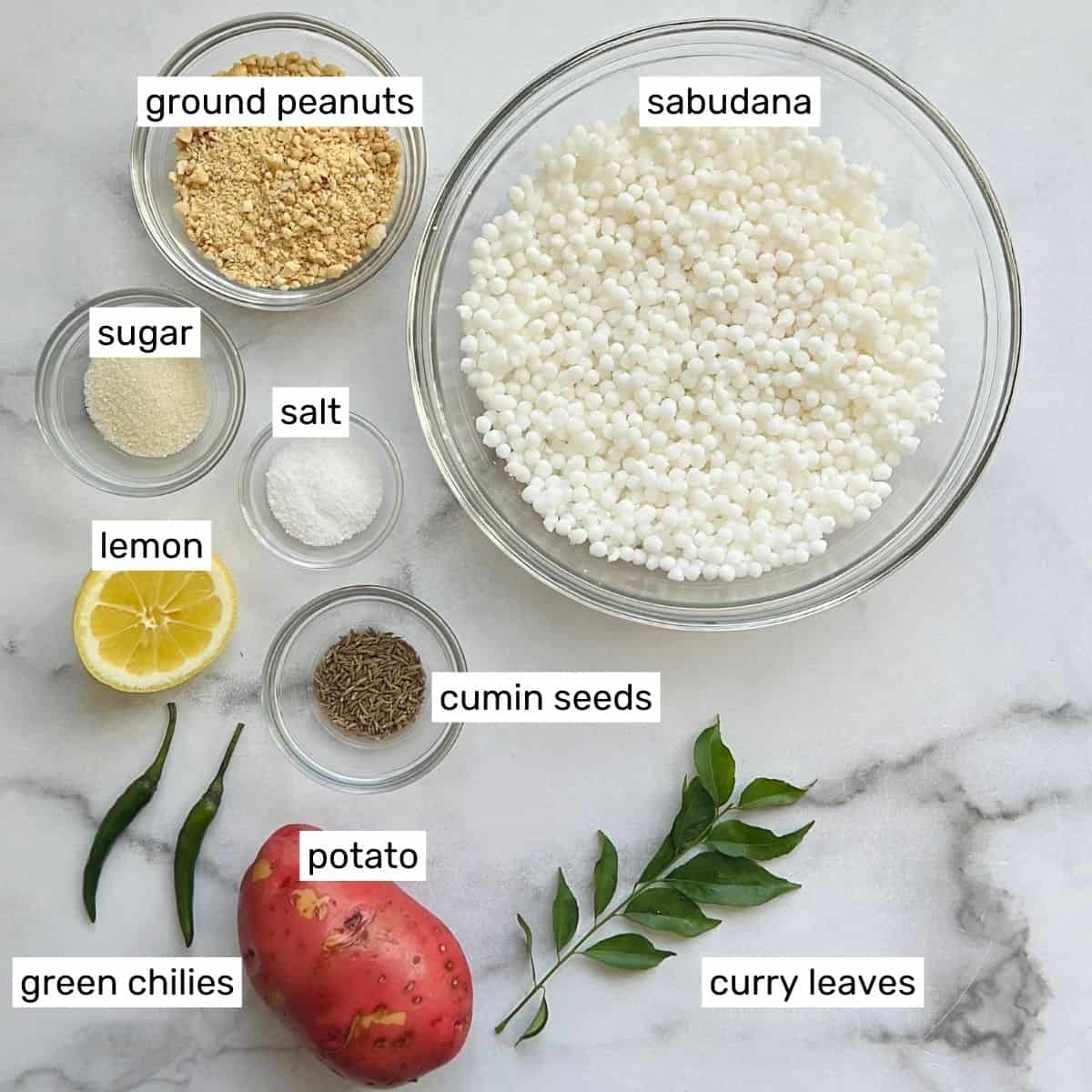
How to make sabudana khichdi
- Add ghee or oil to a nonstick pan. Add cumin seeds and allow them to sizzle. Lower the heat and add curry leaves, green chilies, potatoes, and half of the salt. Mix well and cook covered for 3 to 4 mins on medium heat (photos 1 - 4)
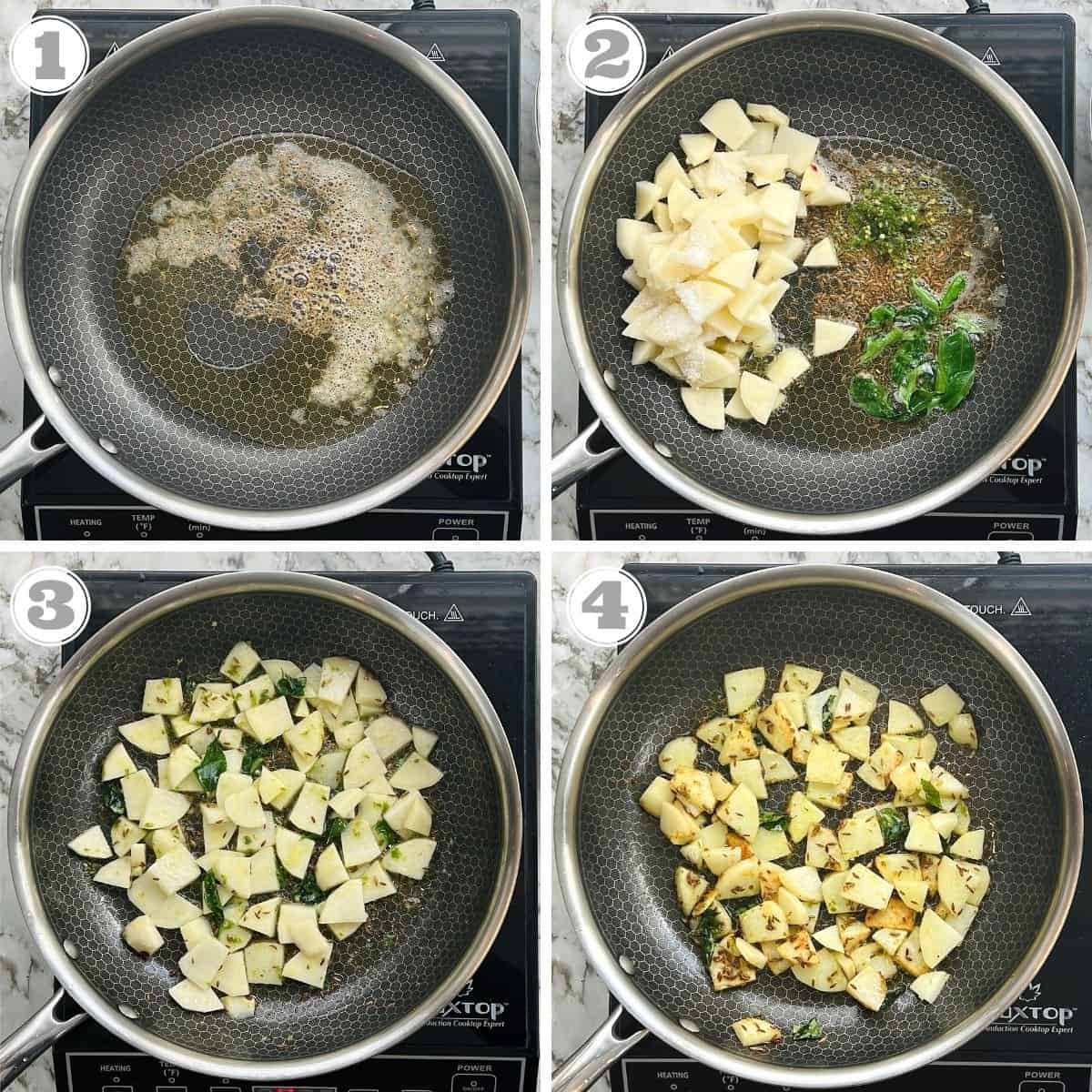
- Add soaked sabudana, crushed peanuts, and remaining salt, mix well, and cook covered for 5 minutes. (photos 5 - 8)
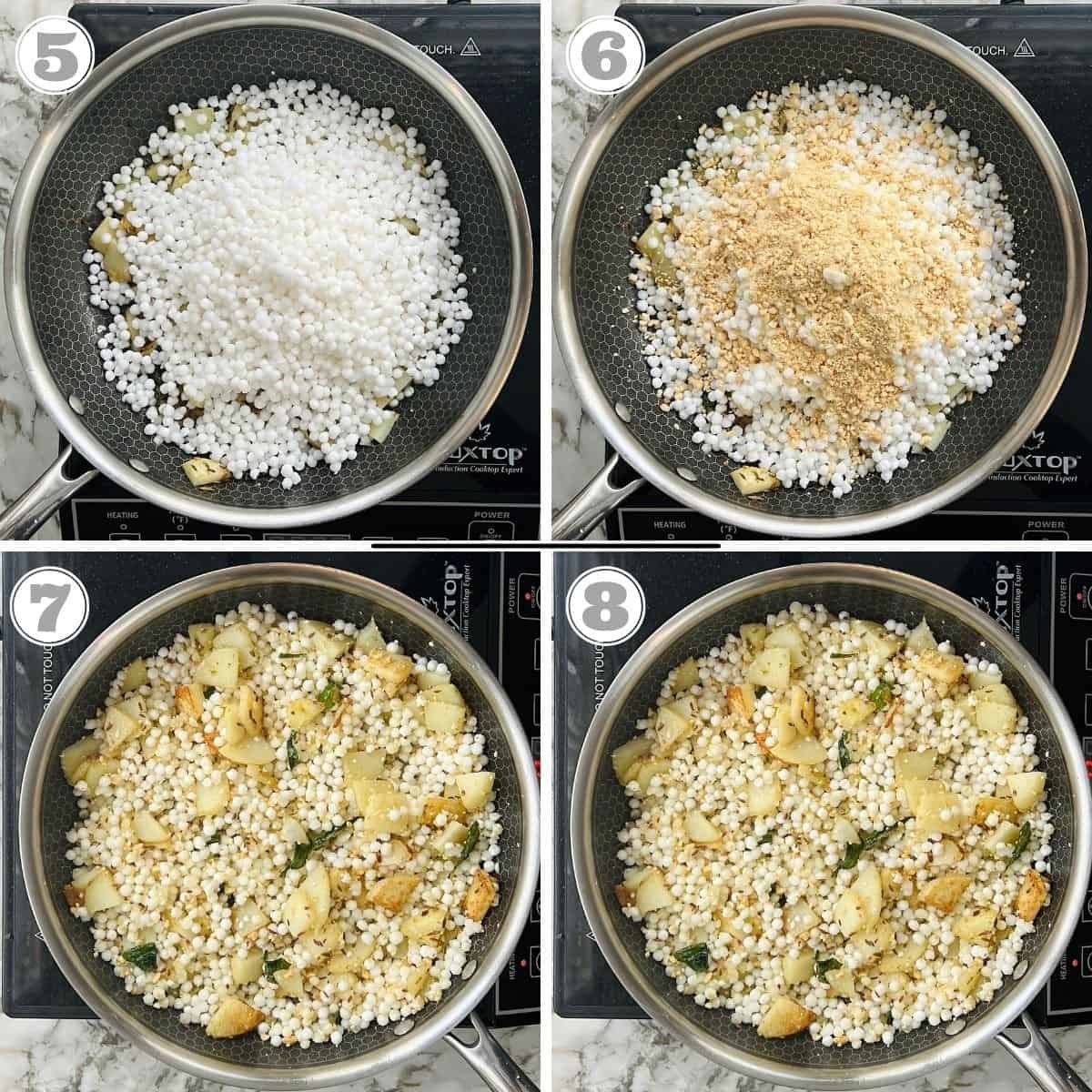
- Add sugar, lemon juice, and cilantro. Mix well
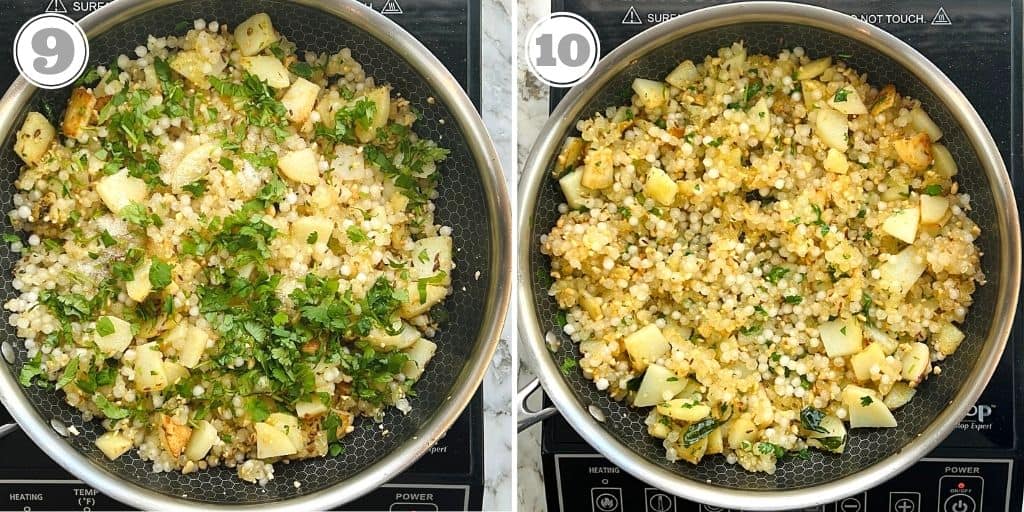
How to serve
Serve Sabudana Khichdi with plain yogurt and lemon pickle. Add a side of Vrat-friendly Sweet Potato Halwa and a glass of Mango Lassi or Rose Lassi for a satisfying meal.
Storing & Reheating
Sabudana khichdi is best served hot. Any leftovers can be refrigerated for 2 to 3 days.
To reheat simply microwave in 30-second intervals. You can also reheat it in a stovetop pan. The khichdi may feel dry after reheating, sprinkle some water on top of it and keep covered for a few minutes.
Tips to Make Non-Sticky, Soft Sabudana Khichdi
- Use good quality sabudana, I recommend using the Swad brand
- Soak Sabudana for at least 4 to 6 hours or overnight. There should be no excess water after it is fully soaked
- Test the sabudana is soaked well by pressing a couple of pearls between your fingers. They should be soft and should be easy to press down
- Cut the potatoes into small thin pieces so they will cook fast and even
- Dry roast the peanuts. Allow them to completely cool down and then pulse in a grinder a few times to make a coarse powder. Adding ground peanuts with sabudana will absorb any excess moisture making the khichdi non-sticky
Variations
- When made as a fasting meal my mom skips curry leaves and cilantro. I love adding curry leaves and cilantro for the taste and nutrition. I have also seen friends adding veggies like diced carrots and peas
- This vegetarian recipe is gluten-free, if you are vegan, substitute ghee with neutral cooking oil
- Substitute minced green chilies with red chili powder
Frequently Asked Questions
Soaking sabudana overnight or 5 to 6 hours gives the best results. If you forget to soak it, you can also soak it in warm water for 30 minutes. Drain out all the water and keep covered for another 30 minutes to an hour.
I do not recommend boiling sabudana for this recipe. It will make the sabudana sticky and chewy.
Adding more green chili will make the sabudana khichdi spicy.
Recipe
Sabudana Khichdi Recipe
Equipment
Recipe Video
Ingredients
- 1 cup sabudana (also known as sago or tapioca pearl)
- 1 cup water for soaking
- 2 tablespoons ghee
- 1 tablespoon cumin seeds
- 2 green chilies minced
- 10 curry leaves optional
- 1 medium Potato peeled and thinly sliced into 1-inch squares
- ⅓ cup roasted ground peanuts roughly ground
- 1½ teaspoons kosher salt divided
- 2 teaspoons sugar
- 2 teaspoons lemon juice
- ¼ cup cilantro finely chopped
Instructions
- Rinse sabudana and drain out all the water. Add water and soak sabudana for 4 to 6 hours or overnight.
- Heat ghee in a nonstick pan. Add cumin seeds and allow them to sizzle
- Lower the heat and add curry leaves, green chilies, potatoes, and half of the salt. Mix well and cook covered for 3 to 4 minutes
- Add soaked sabudana, peanuts and remaining salt, mix well and cook covered for 5 minutes or until the sabudana is cooked soft and most pearls will have turned translucent.
- Add sugar, lemon juice, and cilantro. Mix well and enjoy with plain yogurt
Notes
- Use good quality sabudana, I recommend using the Swad brand
- Soak Sabudana for at least 4 to 6 hours or overnight. There should be no excess water after it is fully soaked
- Test the sabudana is soaked well by pressing a couple of pearls between your fingers. They should be soft and should be easy to press down
- Cut the potatoes into small thin pieces so they will cook fast and even
- Dry roast the peanuts. Allow them to completely cool down and then pulse in a grinder a few times to make a coarse powder. Adding ground peanuts with sabudana will absorb any excess moisture making the khichdi non-sticky
- You can add veggies like diced carrots and peas along with potatoes
- This vegetarian recipe is gluten-free, if you are vegan, substitute ghee with neutral cooking oil
- Minced green chilies can be substituted with red chili powder







Roger Furman says
Thank you for the recipe. I made this and it is delicious. I was introduced to Sabudana Khichdi many years ago by a friend from India who I no longer see. His wife sent it along with him to work for his lunch and Ram shared it with me. I was entranced. I now finally have the opportunity to repeat the pleasure of tasting it again. Thanks again.
Archana says
Thank you for feedback. I am so glad you made it.